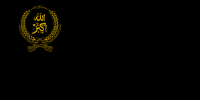National Islamic Front of Afghanistan
National Islamic Front of Afghanistan محاذ ملی اسلامی افغانستان | |
|---|---|
 | |
| Leader | Hamed Gailani (since 2017) |
| Founder | Ahmed Gailani |
| Founded | 1979 |
| Headquarters | Kabul |
| Ideology | Afghan nationalism Pashtun Interests Royalism (formerly) |
| Political position | Right-wing |
| Religion | Sunni Islam |
| Seats in the Leadership Council | 0 / 30 |
| Party flag | |
 | |
| Website | |
| Facebook page | |
| National Islamic Front of Afghanistan | |
|---|---|
| محاذ ملی اسلامی افغانستان | |
| Leader | Ahmed Gailani |
| Dates of operation |
|
| Country | Afghanistan |
| Ideology | Afghan nationalism Anti-communism Royalism |
| Part of | Afghan Mujahideen (1979–1989) |
| Allies |
Non-state Allies: |
| Opponents | State Opponents:
Non-state Opponents: |
| Battles and wars | |
National Islamic Front of Afghanistan (Mahaz-e Milli-ye Islami-ye Afghanistan, Mahaz-i Milli-yi Islami-yi Afghanistan) is a political party in Afghanistan.[1][2] It has been led, since its founding, by members of a prominent Sufi family, the Gailani. It is primarily (but not exclusively) a Pashtun party, followers of the Sufi holy man Pir Sayed Ahmed Gailani have a reputation for moderate thought and the traditional mystical and introspective religious currents that characterize Sufism in that sect.
History
[edit]Formation & role in the Soviet War in Afghanistan
[edit]The party was formed in 1979 in Peshawar, Pakistan,[3] where Gailani had fled to following the rise to power of the communist PDPA in Afghanistan. The party was largely moderate and royalist, with ties to the former royal family.
This party was a member of the Peshawar Seven, and was used by the Pakistani ISI for distributing CIA-funded weapons to the mujahideen fighting the Soviet occupation. NIFA had the most liberal and secular stance of all the Peshawar parties, and it supported the return of King Zahir Shah from exile.[4] Representing the interests of the pre-war Pashtun establishment, it rejected both communism and Islamism, in favour of "nationalism and democracy."[5] The party line emphasized freedom for individuals, the press, and organizations, whilst advocating the separation of powers of government.[6]
The party had a local following in Paktia and Nangarhar, partly due to family tribal ties of Gailani.[7]
Gailani's constituency was drawn from the following of the Qadiryyah, and his group functioned like a Sufi order, greatly hampering its efficiency as a political and military organisation. The followers of the pir always expected to interact with him personally, which meant that the party functioned like a court, centered on Gailani and his children, rather than like a modern party. No decision was ever delegated. The quantity of weapons a NIFA mujahideen commander could expect to receive depended mostly on his personal relation with the pir. Also the pir's tradition of generosity led to many abuses, with many party officials receiving essentially fictitious posts through personal contacts.[8]
Despite this, NIFA remained the most popular party among the Afghan refugees living in Pakistan. A poll carried out in 1987 revealed that 456 refugees out of a sample of 2,000 supported NIFA, which was the highest score of any of the mujahideen parties.[9] By contrast, the Pakistanis, judging the group inefficient allocated NIFA only 10-11 percent of the weapons procured by the CIA, with a much larger share going to Islamist groups, in particular Hekmatyar's Hezb-e-Islami Gulbuddin.[10]
Following the Soviet Withdrawal
[edit]During the 1990s, it was a minor party within the Northern Alliance.
In 1991, they fought in Kuwait against Ba'athist Iraq during the Gulf War.[11]
Gailani supported the candidacy of Karzai in the 2004 presidential election.[3]
In November 2009 Lal Mohammad, a senior official in the party was assassinated by gunmen mounted on a motorcycle.[12]
References
[edit]- ^
John L. Esposito (2004). The Oxford dictionary of Islam. Oxford University Press. p. 92. ISBN 978-0-19-512559-7.
He was succeeded by his sons, Sher agha Jan (Sayyid Ali Gaylani, b. 1923) and the Effendi Jan (Sayyed Ahmad Gaylani, b. 1932), who left Kabul in 1978 and headed the National Islamic Front, Mahaz-e Milli-ye Islami-ye Afghanistan, in Peshawar during the jihad against the Soviet occupation.
- ^
"The 2009 Presidential and Provincial Council Electionsin Afghanistan" (PDF). National Democratic Institute. 2009. p. 49. Archived (PDF) from the original on 12 July 2011.
Four of the Paktika provincial council members are affiliated with the Mahaz Mili Islami Afghanistan party and one is affiliated with the Jamiat Islami Afghanistan party.
- ^ a b http://www.afghan-bios.info/index.php?option=com_afghanbios&id=569&task=view&total=2869&start=865&Itemid=2 Gilani, Pir Sayed Ahmad Gailani – Afghan Biographies
- ^ Vogelsang, Willem (2002). The Afghans. Malden: Blackwell Publishers. p. 316. ISBN 978-0-631-19841-3.
- ^ Rubin, Barnett (1995). The fragmentation of Afghanistan. New Haven: Yale University Press. p. 203. ISBN 0-300-05963-9.
- ^ http://www.refworld.org/docid/3ae6ad1014.html Pakistan/Afghanistan: Information on the National Islamic Front of Afghanistan (NIFA), in particular, its activities in Quetta, Baluchistan, and whether the organization issue certificates of identity to Afghan refugees in Pakistan between 1990 and 1998
- ^ Amstutz, J. Bruce (1994). Afghanistan: The First Five Years of Soviet Occupation. Diane Publishing. ISBN 978-0-7881-1111-2. OCLC 948347893.
- ^ Edwards, David (2002). Before Taliban: Genealogies of the Afghan Jihad. Berkeley: University of California Press. p. 274. ISBN 978-0-520-22861-0.
- ^ Urban, Mark (1990). War in Afghanistan. London: Palgrave MacMillan. p. 223. ISBN 0-333-51477-7.
- ^ Yousaf, Mohammad; Adkin, Mark (2001). Afghanistan: The Bear Trap. Havertown: Casemate. p. 105. ISBN 0-9711709-2-4.
- ^ "DESERT SHIELD AND DESERT STORM A CHRONOLOGY AND TROOP LIST FOR THE 1990–1991 PERSIAN GULF CRISIS" (PDF). apps.dtic.mil. Archived (PDF) from the original on 12 April 2019. Retrieved 18 December 2018.
- ^
Zabihullah Ihsas, Hamid (3 November 2009). "Ex-jihadi commander, teacher killed in north by Zabihullah Ihsas & Hamid on 3 November 2009–13:30". Pahjwok Afghan News. Archived from the original on 13 March 2012.
Gul Ahmad, son of the 55-year-old, said his father had no political relations with anyone and solved people's problems through jirgas. He added his father was a commander of the Jmiat Islami Faction before joining the Mahaz Mili Faction that might be a reason behind his killing.
- Program for Culture and Conflict Studies. Wardak. US Naval Postgraduate School. Last updated 23 January 2009.
- 1979 establishments in Afghanistan
- Afghan nationalism
- Anti-Soviet factions in the Soviet–Afghan War
- Islamic political parties in Afghanistan
- Islamic Unity of Afghanistan Mujahideen
- National Islamic Front of Afghanistan politicians
- Nationalist parties in Afghanistan
- Political parties established in 1979
- Political parties in Afghanistan
